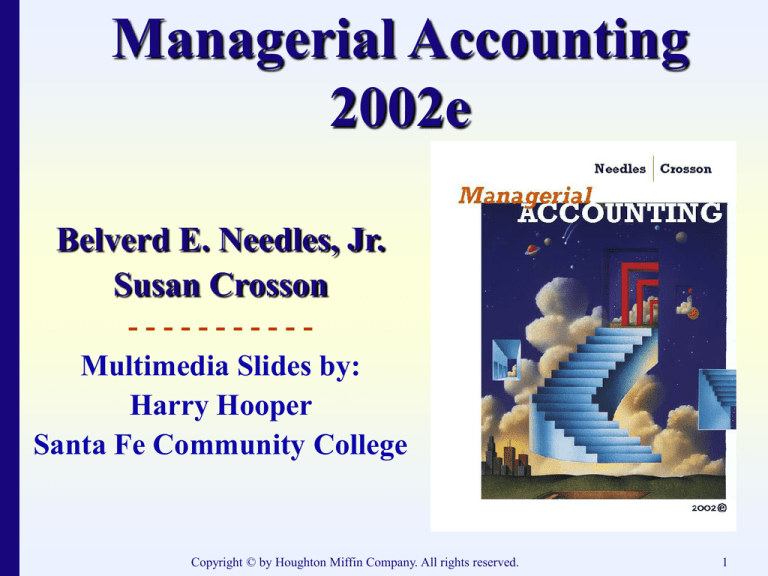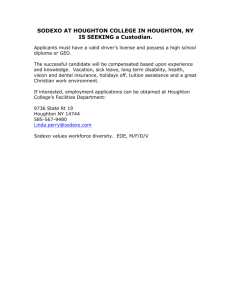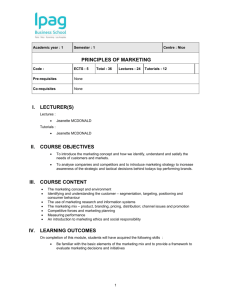
Managerial Accounting
2002e
Belverd E. Needles, Jr.
Susan Crosson
----------Multimedia Slides by:
Harry Hooper
Santa Fe Community College
Copyright © by Houghton Miffin Company. All rights reserved.
1
Chapter 5
Activity-Based
Systems:
Activity-Based
Management and
Just-in-Time
Copyright © by Houghton Miffin Company. All rights reserved.
2
LEARNING OBJECTIVES
1. Explain the role of activity-based
systems in the management cycle.
2. Define activity-based management
(ABM) and discuss its relationship with
the supply network and value chain.
3. Distinguish between value-adding and
nonvalue-adding activities, and
describe process value analysis.
Copyright © by Houghton Miffin Company. All rights reserved.
3
LEARNING OBJECTIVES
4. Define activity-based costing and
explain how a cost hierarchy and a
bill of activities are used.
5. Define the just-in-time (JIT)
operating philosophy and identify
the elements of a JIT operating
environment.
Copyright © by Houghton Miffin Company. All rights reserved.
4
LEARNING OBJECTIVES
6. Identify the changes in product
costing that result when a firm adopts
a JIT operating environment.
7. Define and apply backflush costing,
and compare the cost flows in
traditional and backflush costing.
8. Compare ABM and JIT as activitybased systems.
Copyright © by Houghton Miffin Company. All rights reserved.
5
Activity-Based Systems
and Management
OBJECTIVE 1
Explain the role of activity-based
systems in the management cycle.
Copyright © by Houghton Miffin Company. All rights reserved.
6
Activity-Based Systems
To
create value and to satisfy customer
needs for quality, reasonable price, and
timely delivery, managers must:
Copyright © by Houghton Miffin Company. All rights reserved.
7
Activity-Based Systems
Work with suppliers and customers.
View the organization as a collection of
value-adding activities.
Use resources for value-adding activities
Reduce or eliminate nonvalue-adding
activities.
Know the total cost of creating value for a
customer.
Copyright © by Houghton Miffin Company. All rights reserved.
8
Managers
work with suppliers and
customers:
To
improve quality
To reduce costs
To improve delivery time
Copyright © by Houghton Miffin Company. All rights reserved.
9
Activity-Based Systems
Managers
need to know the full product cost.
Managers
focus internally to use resources in the
best way by matching resources to activities that
add value.
Full
product cost includes not only the costs of
direct materials and direct labor, but also the costs
of all production and non-production activities
required to satisfy the customer.
Activity-based
systems are information systems
that provide quantitative information about the
cost generating activities in an organization.
Copyright © by Houghton Miffin Company. All rights reserved.
10
Using Activity-Based Systems in
the Management Cycle
Product
costing information helps
improve operating processes and make
better pricing decisions.
Copyright © by Houghton Miffin Company. All rights reserved.
11
Planning Stage
In
the planning stage,managers want
answers to questions like:
Which activities add value to a product
or service?
What resources are needed to perform
those activities?
How much should the product or service
cost?
Copyright © by Houghton Miffin Company. All rights reserved.
12
Activity-Based Systems and the Management Cycle
Copyright © by Houghton Miffin Company. All rights reserved.
13
Executing Stage
In
the executing stage, managers want
answers to questions like:
What
is the actual cost of making our
product or providing our service?
What
How
activities are being performed?
well are the activities being performed?
What
resources are being consumed?
Also,
remaining nonvalue-adding
activities must be monitored.
Copyright © by Houghton Miffin Company. All rights reserved.
14
Reviewing Stage
In
the reviewing stage, managers want
answers to questions like:
What actions will reduce the full product cost?
Did we meet our cost-reduction goals for
nonvalue-adding activities?
Measure
activities’ performance by
investigating the difference between their
actual and budgeted costs.
Copyright © by Houghton Miffin Company. All rights reserved.
15
Reporting Stage
In
the reporting stage, internal reports
show the application of the costs of
activities to cost objects, and external
reports answer questions like:
How much does inventory cost?
Did the company earn a profit?
Copyright © by Houghton Miffin Company. All rights reserved.
16
Discussion
Q. What is an activity-based system?
A. Activity-based systems are
information systems that provide
quantitative information about the
cost generating activities in an
organization and create opportunities
to improve the costing information
supplied to managers.
Copyright © by Houghton Miffin Company. All rights reserved.
17
Activity-Based Management and
Activity-Based Costing
OBJECTIVE 2
Define activity-based management
(ABM) and discuss its relationship with
the supply network and value chain.
Copyright © by Houghton Miffin Company. All rights reserved.
18
Activity-Based Management
Activity-based
management (ABM) is an
approach to management that includes:
Identifying all major operating activities.
Determining what resources are
consumed by each activity.
Categorizing the activities as either
adding value to a product or service or
not adding value.
Copyright © by Houghton Miffin Company. All rights reserved.
19
Activity-Based Management
Focuses
on the reduction or elimination of
nonvalue-adding activities.
ABM
provides financial and operational
performance information at the activity
level that:
Is helpful for making decisions about product
lines, market segments and customer groups.
Helps managers eliminate waste and
inefficiencies and redirect resources to activities
that add value to the product or service.
Copyright © by Houghton Miffin Company. All rights reserved.
20
Activity-Based Costing
ABC
is the tool used in an ABM
environment to assist in assigning
activity costs to cost objects for
product costing and decision
making.
Improves pricing and profitability
decisions and inventory valuations.
Copyright © by Houghton Miffin Company. All rights reserved.
21
Supply Networks and
Value Chains
Two
tools of ABM, supply chains and
value chains, help managers better
understand their organization’s
external and internal operations.
Copyright © by Houghton Miffin Company. All rights reserved.
22
Supply Network
A supply
network is an interdependent web
of organizations that supply materials,
products, or services to a customer.
A supply network includes suppliers and
suppliers’ suppliers as well as customers and
customers’ customers.
It moves from materials through production,
distribution and retailing to the final customer.
Copyright © by Houghton Miffin Company. All rights reserved.
23
Value Chain
A value
chain is a related sequence of valuecreating activities within an organization.
It helps managers better understand the
interdependencies of those activities.
A company’s value chain is part of its supply
chain.
It includes the value chains of suppliers and
customers.
Copyright © by Houghton Miffin Company. All rights reserved.
24
Supply Network and Value Chain for a Manufacturing Company
Copyright © by Houghton Miffin Company. All rights reserved.
25
Value Chain
When
organizations work
cooperatively with others in their
supply chain or larger value chain, new
processes can be introduced to reduce
the total cost of products or services.
Copyright © by Houghton Miffin Company. All rights reserved.
26
ABM in a Service Organization
The
supply network includes the
suppliers of goods and services, the
organization itself, its customers and
the customers’ customers.
The value chain includes marketing,
market research, purchasing supplies,
processing orders, providing services
and customer relations.
Copyright © by Houghton Miffin Company. All rights reserved.
27
Supply Network and Value Chain for a Service Organization
Copyright © by Houghton Miffin Company. All rights reserved.
28
Discussion
Q. What is a supply chain?
A. A supply chain is an interdependent
collection of organizations that
supplies materials, products, or
services to a customer.
Copyright © by Houghton Miffin Company. All rights reserved.
29
Value-Adding and NonvalueAdding Activities and Process
Value Analysis
OBJECTIVE 3
Distinguish between value-adding
and nonvalue-adding activities, and
describe process value analysis.
Copyright © by Houghton Miffin Company. All rights reserved.
30
Value-Adding Activities
A value-adding
activity is an activity that
adds value to a product or service as
perceived by the customer.
Examples
include:
Designing
a car.
Assembling
Painting
a car.
a car.
Installing
brakes on a car.
Copyright © by Houghton Miffin Company. All rights reserved.
31
Nonvalue-Adding Activities
A nonvalue-adding
activity is an
activity that adds cost to a product or
service but does not increase its market
value.
Examples
include:
Moving materials.
Storing materials.
Copyright © by Houghton Miffin Company. All rights reserved.
32
Process Value Analysis
Process
value analysis (PVA) is an
analytical method of identifying all
activities and relating them to events that
cause or drive the need for the activities
and the resources consumed.
Copyright © by Houghton Miffin Company. All rights reserved.
33
Costs and Resources
By
identifying nonvalue-adding activities,
organizations can reduce costs and
redirect resources to value-adding
activities.
To
manage the cost of an activity, the
frequency of the activity can be reduced
or it can be eliminated.
Outsourcing
may also reduce costs.
Copyright © by Houghton Miffin Company. All rights reserved.
34
Value-Adding Activities
in a Service Organization
Western Data Services, Inc.
Value-Adding Activities for the Classic Letter
Value-Adding Activities
How the Activity Adds Value
Design the letter
Enhances the effectiveness of the
communication
Create a database of customer
names and addresses sorted in
the ZIP code order
Increases the probability that the client
will efficiently and effectively reach
targeted customer group
Verify the conformity of mailing
information with USPS
requirements
Ensures that the client’s mailing will
receive the best postal rate
Process the job
Creates the client mailing
Deliver the letters to the post office Begins the delivery process
Copyright © by Houghton Miffin Company. All rights reserved.
35
Nonvalue Adding Activities in a
Service Organization
Prepare
a job order form and schedule the
job.
Order, receive, inspect and store paper,
envelopes and supplies.
Set up machines to process a specific
lettersize.
Log the total number of items processed in
a batch.
Bill the client and record and deposit
payments.
Copyright © by Houghton Miffin Company. All rights reserved.
36
Discussion
Q. What are examples of nonvalueadding activities?
A. Moving materials.
Storing materials.
Repairing equipment.
Building maintenance.
Copyright © by Houghton Miffin Company. All rights reserved.
37
Implementing
Activity-Based Costing
OBJECTIVE 4
Define activity-based costing and
explain how a cost hierarchy and a
bill of activities are used.
Copyright © by Houghton Miffin Company. All rights reserved.
38
To implement ABC, managers:
1. Identify and classify each activity.
2. Estimate the cost of resources for each
activity.
3. Identify a cost driver for each activity and
estimate the quantity of each cost driver.
4. Calculate an activity cost rate.
5. Assign costs to cost objects based on the
level of activity required to make the
product or provide the service.
Copyright © by Houghton Miffin Company. All rights reserved.
39
Cost Hierarchy
Many
companies use a cost hierarchy to
manage the assignment of activity-based
costs to the level at which costs are
incurred.
A cost
hierarchy for a manufacturer
typically has four levels:
Unit level.
Batch level.
Product level.
Facility level.
Copyright © by Houghton Miffin Company. All rights reserved.
40
Unit-Level Activities
Unit-level
activities are performed each
time a unit is produced.
These
activities vary with the number of
units produced.
Insertion
of a component during assembly.
Examples:
assembling engine
subassemblies, connecting engines to car
frames
Copyright © by Houghton Miffin Company. All rights reserved.
41
Batch-Level Activities
Batch-level
activities are performed
each time a batch of goods is produced.
These
activities vary with the number of
batches prepared.
Examples:
setup, scheduling, and
materials handling.
Copyright © by Houghton Miffin Company. All rights reserved.
42
Product-Level Activities
Product-level
activities are performed
to support the diversity of products in a
manufacturing plant.
Examples:
implementing engineering
change notices,
redesigning
the installation process.
Copyright © by Houghton Miffin Company. All rights reserved.
43
Facility-Level Activities
Facility-level
activities are performed
to support a facility’s general
manufacturing process.
Examples:
lighting the manufacturing
plant,
securing
the manufacturing plant,
insuring
the manufacturing plant.
Copyright © by Houghton Miffin Company. All rights reserved.
44
The
cost hierarchy includes both
value-adding and nonvalue-adding
activities.
Service
organizations also use a cost
hierarchy.
Copyright © by Houghton Miffin Company. All rights reserved.
45
Sample Activities in Cost Hierarchies
Activity Level
Car Manufacturer:
Engine Installation
Direct Mail Service:
Preparing Bank
Customer Mailing
Unit level
Install engine
Test engine
Print and fold letter
Insert letter and other
information into envelope
Seal and meter envelope
Batch level
Set up installation process
Move engines
Inspect engines
Retool machines
Verify correct postage
Bill client
Product or
service level
Redesign installation
process
Train employees
Develop and maintain
computer systems and
databases
Facility or
operations level
Provide facility management,
maintenance, lighting,
security, and space
Provide facility
management,
maintenance, lighting,
security, and space
Copyright © by Houghton Miffin Company. All rights reserved.
46
Bill of Activities
A bill
of activities is a list of activities
and related costs that is used to
compute the costs assigned to
activities and the product unit cost.
Copyright © by Houghton Miffin Company. All rights reserved.
47
Bill of Activities
More
complex bills of activities include
cost pool rates and cost driver levels used
to assign costs to cost objects.
A bill
of activities may be used as the
primary document or a supporting
schedule to calculate the product unit cost
in job order or process costing for
manufacturing and service organizations.
Copyright © by Houghton Miffin Company. All rights reserved.
48
Activity-Based Costing for Selling
and Administrative Activities
ABC
can be used to group S&A
activities and assign the costs of those
activities to cost objects such as sales
territories or customer groups.
S&A cost pools include salaries,
depreciation, sales commissions and
utilities.
Cost drivers may include number of
sales calls, sales orders, invoices or
billings.
Copyright © by Houghton Miffin Company. All rights reserved.
49
Discussion
Q. What are the four cost hierarchy levels
common to a manufacturer?
A. 1. Unit level.
2. Batch level.
3. Product level.
4. Facility level.
Copyright © by Houghton Miffin Company. All rights reserved.
50
The New Manufacturing
Environment and JIT Operations
OBJECTIVE 5
Define the just-in-time (JIT)
operating philosophy and identify
the elements of a JIT operating
environment.
Copyright © by Houghton Miffin Company. All rights reserved.
51
Traditional Operating Environment
In a traditional operating environment, a
company usually:
1. Maintains large amounts of inventory.
2. Uses push-through production methods.
3. Purchases materials in larger lot sizes with
fewer deliveries.
4. Performs infrequent setups (long production
runs).
5. Manufactures products in batches.
6. Uses a work force skilled in only one area.
Copyright © by Houghton Miffin Company. All rights reserved.
52
The New Environment
The new manufacturing environment
emphasizes streamlined and improved
manufacturing.
1. Waste in materials, inventory, labor, space,
and production time are reduced.
2. Recordkeeping is reduced.
3. The number of nonvalue-adding activities can
be reduced.
4. The sources of poor quality products, services
or materials can be pinpointed and
eliminated.
Copyright © by Houghton Miffin Company. All rights reserved.
53
JIT: Basic Concepts
Underlying the new methods are several basic
concepts.
1. Simple is better.
2. The quality of the product or service is critical.
3. The work environment must emphasize continuous
improvement.
4. Maintaining inventories wastes resources and may hide
poor work.
5. Any activity or function that does not add value should
be reduced.
6. Goods should be produced only when needed.
7. Workers must be multiskilled and participate in
improving efficiency and quality.
Copyright © by Houghton Miffin Company. All rights reserved.
54
JIT Operating Environment
The elements of a JIT operating
environment are:
1. Maintain minimum inventory levels.
2. Develop pull-through production
planning and scheduling.
3. Purchase materials and produce as
needed, in smaller lot sizes.
4. Perform quick, inexpensive machine
setups.
Copyright © by Houghton Miffin Company. All rights reserved.
55
5. Create flexible manufacturing work cells.
6. Develop a multiskilled work force.
7. Maintain high levels of product quality.
8. Enforce a system of effective preventive
maintenance.
9. Encourage continuous improvement of
the work environment.
Copyright © by Houghton Miffin Company. All rights reserved.
56
Discussion
Q. What is pull-through production?
A. Pull-through production is a system
in which a customer’s order triggers
the purchase of materials and the
scheduling of production for the
required products.
Copyright © by Houghton Miffin Company. All rights reserved.
57
Accounting for
Product Costs in the New
Manufacturing Environment
OBJECTIVE 6
Identify the changes in product costing
that result when a firm adopts a JIT
operating environment.
Copyright © by Houghton Miffin Company. All rights reserved.
58
Traditional Operating Environment
The traditional operating
environment divides the production
into five parts:
1. Processing time.
2. Inspection time.
3. Moving time.
4. Queue time.
5. Storage time.
Copyright © by Houghton Miffin Company. All rights reserved.
59
JIT Operating Environment
In
product costing under JIT, costs
associated with processing time are grouped
as either materials costs or conversion
costs.
Conversion
costs include the total of direct
labor costs and manufacturing overhead
costs incurred by a production department,
JIT work cell, or other work center.
Copyright © by Houghton Miffin Company. All rights reserved.
60
JIT Operating Environments
Costs
of
Inspection
Moving
Queue time
Storage time
should be reduced or eliminated
because these are nonvalue-added
activities.
Copyright © by Houghton Miffin Company. All rights reserved.
61
Throughput Time
The
key measure in a JIT operating
environment is throughput time.
Throughput
time is the time it takes
to move a product through the entire
production process.
Copyright © by Houghton Miffin Company. All rights reserved.
62
Changes Caused by JIT:
Direct Versus Indirect Costs
Traditional
Environment
JIT
Environment
Direct
Direct
Indirect
Indirect
Indirect
Indirect
Indirect
Indirect
Indirect
Materials and parts
Direct labor
Repairs and maintenance
Materials handling
Operating supplies
Utility costs
Supervision
Depreciation
Supporting service functions
Indirect
Indirect
Building occupancy
Insurance and taxes
Copyright © by Houghton Miffin Company. All rights reserved.
Direct
Direct
Direct to work cell
Direct to work cell
Direct to work cell
Direct to work cell
Direct to work cell
Direct to work cell
Mostly direct to
work cells
Indirect
Indirect
63
Assigning Costs
In
the JIT operating environment, indirect
costs have little correlation with direct
labor hours.
Since
automation has replaced direct labor
hours with machine hours, machine hours
become more important with JIT.
Depreciation
costs are based on output
units (not time), so are charged directly to
work cells.
Copyright © by Houghton Miffin Company. All rights reserved.
64
Indirect Costs
Several
costs that were treated as indirect
costs in a traditional production
environment are directly traceable to a JIT
production cell such as materials handling,
utilities, supplies and supervision.
Only
costs associated with building
occupancy, insurance, and property taxes
remain indirect costs of work cells.
Copyright © by Houghton Miffin Company. All rights reserved.
65
Discussion
Q. What are some indirect costs associated
with work cells in a JIT operating
environment?
A. Only facility-level activities costs remain
indirect costs of work cells, such as:
costs of building occupancy, insurance
and property taxes.
Copyright © by Houghton Miffin Company. All rights reserved.
66
Backflush Costing
OBJECTIVE 7
Define and apply backflush costing,
and compare the cost flows in
traditional and backflush costing.
Copyright © by Houghton Miffin Company. All rights reserved.
67
JIT Operating Environment
In
a JIT operating environment, the cost flows
through the accounting system are simplified.
Backflush
costing involves initially accumulating
all product costs in Cost of Goods Sold.
At
period end, work costs backward to determine
the proper inventory account balances.
Recording
time is reduced.
Copyright © by Houghton Miffin Company. All rights reserved.
68
JIT Operating Environment
Since labor costs are reduced, the
accounting system combines direct labor
costs and manufacturing overhead costs
into a single category: conversion costs.
Copyright © by Houghton Miffin Company. All rights reserved.
69
Comparison of Cost Flows in Traditional and Back-flush Costing
Copyright © by Houghton Miffin Company. All rights reserved.
70
Cost Flows through T Accounts in Traditional and Back-flush Costing
Copyright © by Houghton Miffin Company. All rights reserved.
71
Discussion
Q. How does the use of backflush costing
help JIT organizations cut costs?
A. Backflush costing saves recording time
by using fewer accounts and by
recording fewer transactions, which
cuts costs.
Copyright © by Houghton Miffin Company. All rights reserved.
72
Comparison of ABM and JIT
OBJECTIVE 8
Compare ABM and JIT as
activity-based systems.
Copyright © by Houghton Miffin Company. All rights reserved.
73
Similarities of ABM and JIT
Both ABM
and JIT analyze processes and
identify value-adding and nonvalue-adding
activities. They both seek to:
eliminate or reduce nonvalue-adding activities.
improve the allocation of resources.
improve quality, efficiency and productivity.
improve information quality for decision-making.
Copyright © by Houghton Miffin Company. All rights reserved.
74
System Differences
The
two systems differ in their primary
goals.
The
primary goal of ABM is to calculate the
most accurate product cost by using activitybased costing (ABC). ABC is an accounting
method.
The
primary goal of JIT is to simplify and
standardize production and purchasing
activities.
Copyright © by Houghton Miffin Company. All rights reserved.
75
Comparison of ABM and JIT
Approaches to Activity-Based Systems
ABM
JIT
Purpose
Reduce or eliminate
nonvalue-adding
activities
Reduce or eliminate waste.
Cost
assignment
Use ABC to assign
manufacturing overhead costs to the
product cost by
using appropriate
cost drivers
Reorganize service activities so
that they are performed within
work cells and manufacturing
overhead costs incurred in the
work cell become direct costs of
the products made in the work cell
Costing
method
Integrate ABC with
either job order or
process costing to
calculate product costs
Use backflush costing to calculate
product costs when the products
are completed
Copyright © by Houghton Miffin Company. All rights reserved.
76
Discussion
Q. What are some indirect costs associated
with work cells in a JIT operating
environment?
A. Only facility-level activities costs remain
indirect costs of work cells, the costs
associated with the building occupancy,
insurance and property taxes..
Copyright © by Houghton Miffin Company. All rights reserved.
77
OKAY, LET’S REVIEW...
1. Explain the role of activity-based
systems in the management cycle.
2. Define activity-based management
(ABM) and discuss its relationship
with the supply chain and the value
chain.
3. Distinguish between value-adding and
nonvalue-adding activities and
describe process value analysis
Copyright © by Houghton Miffin Company. All rights reserved.
78
CONTINUING OUR REVIEW…
4. Define a cost hierarchy, describe its
elements, and explain how a cost
hierarchy and a bill of activities are
used in activity-based costing.
5. Define the just-in-time (JIT) operating
philosophy and identify the elements
of a JIT operating environment.
Copyright © by Houghton Miffin Company. All rights reserved.
79
AND FINALLY…
6. Identify the changes in product
costing that result when a firm adopts
a JIT operating environment.
7. Define and apply backflush costing,
and compare the cost flows in
traditional and backflush costing.
8. Compare ABM and JIT as activitybased systems.
Copyright © by Houghton Miffin Company. All rights reserved.
80



